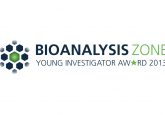2014 Young Investigator: Andrew M Glowacki


Nominee:
Nominated By:
Supporting Comments:
What made you choose a career in bioanalysis?
During my undergraduate years, I was fortunate enough to be able to participate in a research project that used GC–MS to study the effects of ethanol on NSAID medications under simulated gastric conditions. The application of analytical chemistry techniques to a biology and physiology based problem proved interesting to me as understanding concepts from both fields were key to good experimental design. Starting my career in bioanalysis proved to be the natural progression of this problem solving strategy.
Describe the main highlights of your bioanalytical research, and its importance to the bioanalytical community.
Most of the research I conduct is centered on applying new techniques, instrumentation, and equipment to better solve common problems. Particular focuses include microsampling, core shell column technologies, automation, and UHPLC analysis. My approach is to modify tried-and-true bioanalytical techniques one step at a time and assess the effect the new tools have on assay ruggedness and precision. I have found that by combining different emerging technologies with classic bioanalytical approaches, we can achieve many of the goals we focus on as an industry. These include reaching ever lower LLOQs, working with less sample volume from test animals, and reduced turnaround time from sample receipt to data delivery. Each successful implementation of new technology or techniques streamlines the bioanalytical process, and thus helps more efficiently deliver novel therapeutics to the general population.
Describe the most difficult challenge you have encountered in the laboratory and how you overcame it.
My most challenging project to date was developing an assay to quantify an ~2000 Dalton beta-cyclodextrin by LC–MS/MS. This project was particularly challenging because the molecule contained many more carbon and nitrogen atoms than a typical small molecule drug and thus possessed a more complicated isotopic profile. The molecule was also large enough to possess several sites where ionization could take place, leading to the formation of single, double, triple, and quadruple charged ions. Additionally, the molecule contained numerous sites for the inclusion of “R” groups. These “R” groups were either a hydrogen atom or a string of atoms containing carbon, nitrogen, and sulfur. A molecule contained, on average, about seven of these strings of atoms in place of a hydorgen atom. The project aimed to quantify all of these structures as a single drug. The problem was solved by using high resolution LC–MS in order to better understand how the individual structures ionized and chromatographed. Once this was completed and the molecule better understood, a single LC–MS/MS method was developed and validated.
Where do you see your career in bioanalysis taking you?
So far, I’ve been fortunate to receive many opportunities to learn and exchange ideas and methodologies with professionals from a variety of backgrounds. These professionals include individuals from academia, the CRO space, pharmaceutical companies, robotics engineers, and equipment vendors. I hope to be able to continue these dialogs and remain aware of fresh, differing perspectives on the ever-changing problems we’re trying to solve as an industry in the ever-changing environment in which we work. I hope to continue to be able to unify new techniques, new tools, and new approaches to overcome some of these challenges and to support the streamlined development of pharmaceutical products for years to come.
How do you envisage the field of bioanalysis evolving in the future?
As bioanalysis evolves, we are able to deliver more detailed information with less sample volume. Better assays, robotics systems, and instrumentation are constantly being developed, allowing us to very accurately quantify lower and lower LLOQs with less sample volume. To me, this means that we’ll be able to use bioanalysis to support projects that were previously restricted by sample volume consideration or instrumental limitations. I believe that some of these evolutions have already begun. I can imagine scientists designing assays to obtain an entire PK curve from a single animal, thereby reducing the number of animals that need to be sacrificed for research purposes while enhancing the data. I can see microsampling techniques supporting pediatric patient population studies where it is particularly advantageous to limit the amount of blood removed from any one child. Finally, as the cost and time to maintain and run sensitive instrumentation is reduced, I can see bioanalysis used in clinical applications where the identification and quantification of biomarkers can provide valuable data on the efficacy of therapeutics to individual patients.
Please list 5 of your recent publications, and select one that best highlights your career to date in the field of Bioanalysis.
1. Glowacki A, Lewis J, Carleton K, Williard C. Thinking forward: adapting emerging technologies to drive rapid throughput ass spectrometry assays.
2. A molecular dynamic study of the effect of a glycine to serine point mutation on the structure of collagen-like model peptides containing a reputed stable region of collagen II. American Chemical Society Award.
3. Comparison of end restraints for the molecular dynamic study of model collagen II-like peptides in explicit water at 310K.



